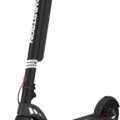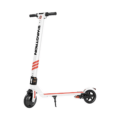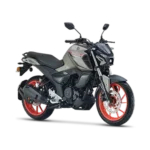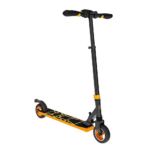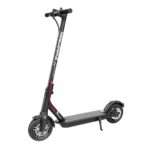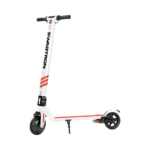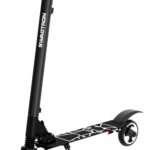- Home
- Scooters
- Electric Scooters
- Swagtron GlideX
Swagtron GlideX
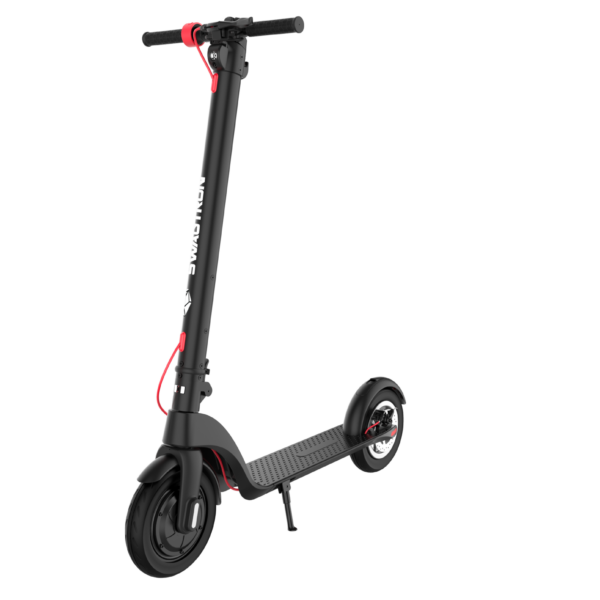

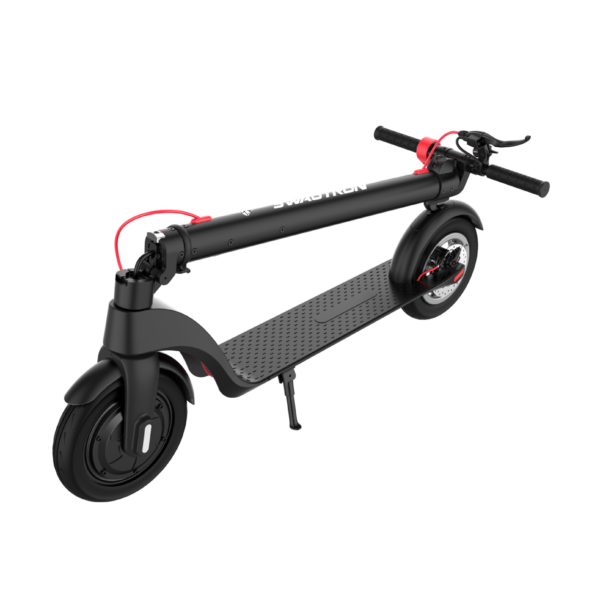
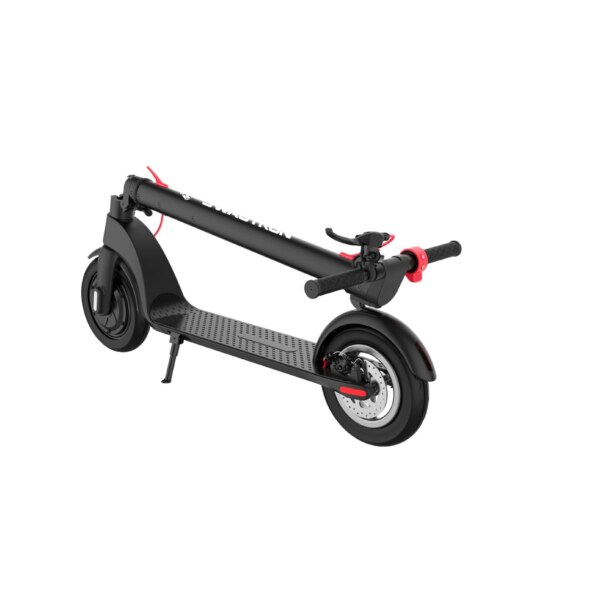
- Battery Range: 15.5 mph (24.9 km/h)
- Top Speed: 15.5 miles (24.9 km)
- Motor Power: 350 W front hub motor
- Weight Capacity: 220 lb (100 kg)
- Charging Time: Not specified
- Scooter Weight: 28.5 lb (12.9 kg)
PROS
- 350 W motor with 15.5 mph (24.9 km/h) top speed
- 15.5-mile (24.9 km) range for short urban trips
- 10-inch tires give more stability than small-wheel scooters
- Relatively light 28.5 lb (12.9 kg) design
- IPX4 splash resistance for light rain
- Front-wheel drive layout for predictable handling
CONS
- Charge time is not clearly specified
- No suspension. rough pavement can feel harsh
- Range will drop for heavier riders and cold weather
- Top speed modest compared with performance models
Key Takeaways
- The Swagtron GlideX is a lightweight, folding electric scooter designed for urban commuting and short trips.
- It features a 350W front hub motor, reaches a top speed of 15.5 mph, and has a claimed range of 15.5 miles under ideal conditions.
- With a focus on practicality, its simple controls and low weight make it user-friendly for new riders.
- The scooter offers a comfortable ride on urban terrain, supported by 10-inch wheels and a sturdy aluminum frame.
- Ideal for commuters and students, the Swagtron GlideX excels in convenience but may not suit heavier riders or long-distance travel.
Table of contents
The Swagtron GlideX is a small, light electric scooter for everyday city use. It trades wild speed for comfort, simplicity, and easy carrying. If you want a scooter that folds fast, fits under a desk, and just works for short trips, the Swagtron GlideX sits right in that zone.
What Is the Swagtron GlideX?
The Swagtron GlideX is a folding electric kick scooter with a 36 volt system and 10 inch wheels. It targets city riders and students who care more about practicality than raw power.
Top speed is rated at 15.5 miles per hour, or about 25 kilometers per hour. The claimed max range is 15.5 miles, roughly 25 kilometers, when you ride in ideal conditions. Rider weight limit sits at 220 pounds, close to 100 kilograms. The scooter itself weighs around 28.5 pounds, so about 12.9 kilograms, and the frame uses aluminum alloy with an IPX4 splash rating.
So on paper, the Swagtron GlideX feels like a true commuter scooter. It runs fast enough for bike lanes and short city hops, yet it stays friendly for new riders.
Everyday use stays simple. You unfold the stem, power the scooter on, pick a riding mode, and press the thumb throttle. One or two brake levers handle stopping. The whole setup feels closer to a slightly heavier kick scooter with power than a big electric moped.
How the Swagtron GlideX Works
The core of the Swagtron GlideX is the 350 watt front hub motor. The motor sits inside the front wheel and pulls the scooter forward when you press the throttle. Power comes from a 36 volt lithium ion battery that lives in the frame.
Between the motor and the battery sits the controller. This small box reads your throttle input and the current riding mode. Then it decides how much current to send to the motor. Light pressure on the throttle gives a calm roll away. A deeper press gives stronger pull and takes you up to the 15.5 mile per hour top speed.
The battery pack holds 6.4 amp hours at 36 volts. That works out to roughly 230 watt hours of energy. A built in management system watches cell voltage and temperature. So the pack charges and discharges in a safe range and avoids over charging.
Braking uses a mix of mechanical parts and electronic control. A mechanical brake on the rear wheel handles most of the stopping work. At the same time, the controller cuts power to the motor as soon as you pull the lever. In practice, you feel a single smooth slow down rather than two separate actions.
Up at the bars, the cockpit keeps things basic. There is a display that shows speed, mode, and battery bars. A thumb throttle sits on one side. One or two brake levers sit near the grips. A small set of buttons lets you change modes and switch the lights on and off. After a short practice session in a quiet lot, most riders feel at home with this layout.
Riding modes change how the Swagtron GlideX responds. A lower mode caps speed and softens throttle response for crowded paths or first rides. A higher mode unlocks the full speed and sharper response. Many people start on the mild setting, then move up once they trust their balance and braking.
Key Specifications
The Swagtron GlideX sits in the light commuter class, and the main numbers reflect that role. These specifications give a clear view of what you get.
| Category | Item | Value |
|---|---|---|
| General | Model | Swagtron GlideX SES01 |
| General | Manufacturer | Swagtron |
| General | Product type | Folding electric kick scooter |
| General | Intended use | Urban commuting and short trips |
| Performance & Power | Motor type | Front hub motor |
| Performance & Power | Motor power | 350 W nominal |
| Performance & Power | Top speed | 15.5 mph (25 km/h) |
| Performance & Power | Claimed max range | 15.5 mi (25 km) on flat routes |
| Performance & Power | Drive layout | Front wheel drive |
| Performance & Power | Rated climbing ability | Up to 15° short grades |
| Battery, Charging & Electrical | Battery type | Lithium-ion pack with internal management |
| Battery, Charging & Electrical | Battery voltage | 36 V |
| Battery, Charging & Electrical | Battery capacity | 6.4 Ah (about 230 Wh) |
| Battery, Charging & Electrical | Charger | 36 V class charger, rating not stated |
| Battery, Charging & Electrical | Typical charge time | Several hours from low to full |
| Battery, Charging & Electrical | Water resistance | IPX4 splash rating |
| Build & Dimensions | Frame material | Aluminum alloy |
| Build & Dimensions | Wheel size | 10 in (254 mm) |
| Build & Dimensions | Scooter weight | 28.5 lb (12.9 kg) |
| Build & Dimensions | Max rider weight | 220 lb (100 kg) |
| Build & Dimensions | Unfolded dimensions | Not stated |
| Build & Dimensions | Folded dimensions | Not stated |
| Safety & Control | Braking system | Mechanical rear brake plus electronic cut off |
| Safety & Control | Lighting | Onboard LED lighting, layout not detailed |
| Safety & Control | Reflectors | Reflectors present |
| Safety & Control | IP rating | IPX4 |
| Features & Extras | Display | Handlebar display with speed and battery level |
| Features & Extras | Riding modes | Multiple modes, details not stated |
| Features & Extras | Cruise Control | Not confirmed for this model |
| Features & Extras | Folding mechanism | Folding stem with manual latch |
| Features & Extras | Kickstand | Side kickstand |
| Warranty & Compliance | Warranty | Swagtron limited scooter warranty |
| Warranty & Compliance | Compliance | Subject to local e-scooter rules |
This table sums up the hardware and gives a quick way to compare the Swagtron GlideX with other scooters in the same class.
Design & Build Quality
The Swagtron GlideX has a clean, simple look. The stem runs straight up from the front of the deck. The deck sits low to the ground. The whole scooter feels compact when you stand next to it.
The aluminum frame keeps weight down but stays stiff enough for the 220 pound rider limit. The deck has enough space for a staggered stance with one foot forward and one slightly back. That stance spreads your weight and helps you stay relaxed in your knees and ankles.
Grip on the deck comes from a textured top surface. Once your shoes settle in, they stay put on rough pavement. The 10 inch wheels help a lot here. Smaller wheels fall into cracks. These larger wheels roll over small holes and seams with less drama.
The folding joint sits down near the front wheel. The latch is manual and easy to reach. You flip it open, fold the stem, then lock it again in the folded position. During setup, you raise the stem, line it up, and close the latch until it clicks. A quick push and pull test on the bars confirms the stem sits tight.
Cables run along the stem and into the deck. They stay close to the frame and avoid big loops. That neat routing keeps the scooter from snagging on doors or railings. It also gives the Swagtron GlideX a tidy look when folded and parked indoors.
Build quality over time depends on small habits. Bolts at the folding joint, stem clamp, and brake mounts need a quick check now and then. A small hex key kit solves most of that. Light cleaning with a damp cloth keeps grit off the hinge and wheel areas. Harsh spray and strong cleaners stay away from seals and painted parts.
Performance Fundamentals
The Swagtron GlideX sits right in the classic 350 watt commuter range. So the ride feels calm and predictable instead of wild.
From a standstill on flat ground, the scooter eases into motion. You press the throttle, the motor pulls steadily, and you reach 10 miles per hour in a short stretch. Then speed builds up toward the 15.5 mile per hour cap. The push is smooth rather than brutal, which works well for new riders.
At full speed, the scooter tracks straight as long as the stem latch stays tight and the wheels are in good shape. The 10 inch wheels and low deck combine to keep your weight close to the ground. Small steering inputs make gentle shifts in line, not sharp jolts.
Hill behavior reflects the 350 watt rating. Short city slopes up to about 7 or 8 percent feel fine for an average weight rider. Steeper hills slow the scooter, especially for riders close to the 220 pound limit. It still climbs. Speed drops, and you may lean a little forward to keep the front wheel planted.
Throttle response feels direct. When you roll off, the scooter eases down in a controlled way. When you press again, power comes back without a long delay. That trait helps in stop and go traffic or on mixed paths with people, bikes, and small obstacles.
Rider stance shapes performance more than many people think. Slightly bent knees, relaxed shoulders, and a staggered stance make the scooter feel planted. Leaning forward when you accelerate and leaning back a bit under hard braking keeps grip on both wheels and shortens stopping distances.
Battery, Range & Efficiency
The battery in the Swagtron GlideX holds 6.4 amp hours at 36 volts, so around 230 watt hours. That size sits in line with many light commuter scooters. It targets short to medium trips, not full day rides.
The claimed range, 15.5 miles or 25 kilometers, reflects ideal conditions. Think smooth pavement, light rider, mild weather, and a lower speed mode. Real life rarely matches that picture.
For a rider around 150 pounds who cruises near 10 to 12 miles per hour on mostly flat ground, the Swagtron GlideX can approach the rated distance. For a rider closer to 200 pounds who stays near top speed and faces some hills, a more realistic figure lands around 9 to 12 miles, so 14 to 19 kilometers.
Speed, hills, and wind all eat into range. Higher speed means more air drag. Hills pull extra current from the pack. Strong headwinds act like a steady climb.
Temperature also changes how the battery behaves. Cold mornings cut range compared with warm days. The cells deliver less energy when they run cool, so trips feel shorter in winter.
Charging works best with a simple routine. Use the correct 36 volt charger. Let the scooter rest a short time after a hard ride, then plug it in. Avoid leaving the battery at 0 percent or 100 percent for long periods. For long breaks, a level around half to three quarters is a good parking spot.
Charge time depends on the charger rating, which is not listed in detail. Packs of this size often take a few hours to go from low to full. Many riders plug in after work, then unplug once the bars reach full or near full.
During long off seasons, store the Swagtron GlideX in a dry room, away from freezing temperatures. Check the battery level every month or two and add a short top up when it drops low. That habit keeps capacity healthy for the next riding season.
Ride Quality & Comfort
Ride feel on the Swagtron GlideX lands in the “firm but fair” category. There is no full suspension, yet the 10 inch wheels and frame geometry keep things under control.
Larger wheels smooth out everyday bumps. Cracks, joints, and small holes feel less harsh than on scooters with tiny 8 inch wheels. The deck stays more stable, and the handlebar jumps less when you hit rough patches.
Tire type on this model is not spelled out in public docs. Some units in this family run air filled tires, others use solid or honeycomb designs. Air tires bring extra comfort and grip but need correct pressure and can get flats. Solid designs remove flat worries and pass more vibration through the frame. In both cases, the big diameter still helps a lot.
Frame stiffness keeps steering direct. The aluminum build does send more road buzz to your feet and hands than a heavy steel frame. A lower deck keeps your center of gravity down near the wheels. That position makes turns feel more secure and eases push starts.
The cockpit layout supports comfort on longer rides. A moderate bar width gives enough leverage for turns without feeling bulky. Soft grips reduce tingling in fingers. A small angle in the bar shape lets your wrists rest in a natural position. After a few days of riding, your hands and shoulders should feel more relaxed as your body discovers a natural stance.
Noise from the 350 watt motor stays mild. Under load, you hear a soft electric whine. At low speeds on smooth ground, the main sound often comes from the tires rather than the motor.
Small habits improve comfort even more. Bending your knees and lifting slightly through the legs over rough spots turns your body into extra suspension. Changing foot position now and then during long stretches keeps muscles from getting stiff. These little adjustments help the Swagtron GlideX feel friendly even on less than perfect streets.
Braking & Safety Features
The Swagtron GlideX relies on a simple brake layout. A mechanical brake on the rear wheel does the main stopping work, and the controller cuts motor power as soon as you pull the lever. So you get one clean, joined response when you slow down.
Good braking starts with smooth inputs. Grabbing the lever in a panic can make the rear wheel slide. A steady pull builds brake force and keeps grip on the tire. Leaning back a little and bending your knees helps your body stay balanced.
Lighting on the Swagtron GlideX covers basic needs. There is onboard LED lighting so other road users can see you in low light. In real night riding, many people add a brighter handlebar light for stronger forward visibility. The built in lights work well as a backup and as “be seen” lights in town.
The IPX4 rating means the scooter handles splashes and light rain. Short rides through shallow puddles or drizzle are fine. Deep water, strong storms, or hose blasts are not. Water in bearings, switches, or housings over time leads to problems that are hard to fix.
Reflective clothing and a good helmet raise safety more than any piece of hardware on the scooter. Gloves with grip help with sudden stops. Bright outer layers and steady lane position make drivers notice you earlier.
Stopping distance changes with surface conditions. On dry, clean pavement, a firm pull on the lever slows the Swagtron GlideX in a short stretch. On wet or sandy ground, you need a softer initial pull, then more pressure as you feel how much grip you have. Practicing a set of stops in a quiet parking lot gives you a real sense of how the scooter behaves.
Portability & Daily Usability
Portability is one of the best parts of the Swagtron GlideX. At 28.5 pounds, it feels easy to pick up for most adults. You can carry it up a flight of stairs or lift it onto a bus without a huge effort.
The folding system keeps things quick. You open the latch at the base of the stem, lower the bar toward the deck, then clip the folded package together. To ride, you lift the stem, snap the latch closed, and give the bar a shake test. That whole routine takes only a short time once you get used to it.
Folded size works well for tight spaces. The scooter slides under a desk, into a closet, or beside a hallway wall. In small apartments and dorm rooms, that matters a lot.
Carrying technique helps with comfort. Many people hold the stem near the middle so the scooter balances in one hand. Others grab closer to the folding joint and let the rear wheel hang slightly lower. Try both and stick with the one that feels easier on your back and wrist.
Security habits matter too. When you lock the Swagtron GlideX outside, loop a sturdy lock through a solid part of the frame and around a fixed rack. A basic cable alone is easy to cut. Indoor storage near an outlet makes charging simple and cuts the risk of theft.
In public transit, etiquette counts. Stand near doors or in corners. Keep the folded scooter close to your legs with the wheels on the floor. Lift the front wheel slightly when crossing gaps or steps so it does not catch.
At home, pick a regular routine. Wipe the scooter down after wet rides. Check the tire condition and pressure if the tires are air filled. Confirm the stem latch still closes firmly. Plug in the charger when the battery sits low, not after every tiny trip, unless you need a full pack every morning.
Swagtron GlideX vs Alternatives
The Swagtron GlideX fits inside a crowded field of light commuter scooters. Even so, it has a few clear traits that set it apart.
Within Swagtron’s own range, the GlideX is the lighter, simpler sibling to bigger models. For example, the Swagtron 5 Elite leans closer to a full featured commuter with more battery and a stronger feel. The Swagtron GlideX strips that concept down for riders who care more about low weight and easy carrying than extra punch.
If you look at other 350 watt scooters from different brands, the Swagtron GlideX lands right in the middle for speed and claimed range. Top speed of 15.5 miles per hour and claimed range of about 15 miles match many rivals. The main gain comes from its modest 28.5 pound weight, which beats a lot of scooters that drift over 30 pounds.
Some commuters in the same class include basic suspension, wider decks, or twin brake setups. Those upgrades add comfort or stopping power and also bring extra weight and more parts to maintain. The Swagtron GlideX keeps a simpler layout. That choice helps new riders who just want a plug in and ride experience.
Then you have stripped down models that sit below the GlideX in price and spec. A scooter like the Swagtron Swagger 8 targets younger riders and very short trips with a lighter frame and smaller wheels. The Swagtron GlideX steps up from that level with a stronger motor, higher limit for rider weight, and larger wheels that feel better for adults.
High power scooters with 500 watt or dual motors live in a different world. They jump away from stops, run at higher speeds, and climb long hills with less effort. They also weigh far more, cost more, and often push past speed limits for shared paths in many places. The Swagtron GlideX stays on the practical side for daily use and legal friendly speeds.
Specs for the Swagtron GlideX sit close to many peers. What stands out is the mix of weight, wheel size, and simple folding. For riders who carry their scooter a lot, those details matter more than a few extra miles per hour on the top end.
Who the Swagtron GlideX Is (and Isn’t) For
The Swagtron GlideX fits a pretty clear crowd.
It works well for office workers who live a few miles from their jobs and want a faster, cleaner way to reach the office. A daily route in the three to seven mile range suits this scooter. You ride in, fold the scooter, park it under your desk, and plug it in near a power strip.
Students make another natural group. Campuses often have low speed limits and a mix of paths and streets. The Swagtron GlideX stays quick enough to cut travel time between classes without feeling scary. It locks to bike racks, folds for crowded hallways, and fits into shared rooms without chewing up space.
The scooter fits last mile riders as well. Maybe you park your car near the edge of a city and ride the rest. Maybe your local bus stop sits far from your door. In both cases, the Swagtron GlideX turns that boring stretch into a quick glide and then folds away in seconds.
The model does not fit every situation though. Riders with long daily routes, say 10 or more miles each way, need more battery. People who live in very hilly areas and weigh close to the 220 pound limit will feel the limits of a single 350 watt motor on long climbs. Riders who want intense acceleration or top speeds past 20 miles per hour should look at stronger scooters.
Parents who plan to share the Swagtron GlideX with a teenager should set clear rules for helmets, allowed routes, and max mode. A short training session together in a parking lot helps everyone agree on safe braking distances, turning habits, and what to do in tricky traffic.
For the right rider, the Swagtron GlideX becomes a daily tool. It cuts travel time, avoids parking stress, and fits neatly into normal life without demanding much space or attention.
Specifications
General
| Model The Model specifies the exact version or name of the scooter. It helps identify its unique design, features, and specifications within the manufacturer’s product line. Knowing the model makes it easier to compare options, find compatible accessories, or look up support information. | GlideX |
| Brand The Brand identifies the manufacturer or company that designs and produces the scooter. A trusted brand is a sign of quality, reliability, and good customer support. Well-known brands often have higher standards for safety, performance, and after-sales service, giving you more confidence in your purchase. | Swagtron |
| Release Date The Release Date indicates when the scooter model was officially launched on the market. This helps you know how current the design, technology, and features are. A newer release date often means updated components, improved performance, and the latest safety or smart features. | 18 November 2025 |
| Recommended Age Recommended Age indicates the minimum age range that the scooter is designed for, based on safety, size, and ease of use. Following the recommended age helps ensure that riders can handle the scooter’s speed, weight, and controls comfortably and safely. Always check local laws and use protective gear, especially for younger riders. | +16 |
Performance & Power
| Motor Power (Wattage) What it means: The motor power, measured in watts (W), shows how strong the scooter’s electric motor is. Why it matters: Higher wattage usually means better acceleration, more torque, and improved performance on hills or rough terrain. For example, a 250W motor is good for flat city roads and light riders, while a 500W or 1000W motor provides more power for faster speeds or climbing steep inclines. | 350 W front hub motor (36 V) |
| Top Speed The Top Speed indicates the maximum speed that the scooter can reach under optimal conditions. It’s usually measured on level ground with a fully charged battery and an average rider weight. A higher top speed allows you to travel longer distances faster, but always ensure you ride within legal speed limits and your personal comfort zone for safety. | 15.5 mph (24.9 km/h) |
| Battery Capacity Battery Capacity refers to the total amount of energy the scooter’s battery can store, usually measured in ampere-hours (Ah) or watt-hours (Wh). A higher battery capacity means you can ride longer distances on a single charge, reducing the need for frequent recharging. Keep in mind that actual range can vary depending on rider weight, terrain, speed, and weather conditions. | 36 V 6.4 Ah (230.4 Wh) lithium-ion battery |
| Estimated Range per Charge The Estimated Range per Charge indicates the average distance the scooter can travel on a single full battery charge. This range is calculated under optimal conditions, such as flat terrain, moderate speed, and average rider weight. Real-world range may vary depending on riding style, terrain, weather, and load. A longer range means fewer recharges and greater freedom for longer trips. | 15.5 miles (24.9 km) |
| Hill Climb Ability Hill Climb Ability describes the maximum incline or slope that the scooter can handle while maintaining stable performance. It’s typically expressed as a percentage or in degrees. A higher hill climb rating means the scooter can tackle steeper hills without losing too much speed or power. Actual climbing performance may vary based on rider weight, battery charge, and terrain conditions. | 15° claimed climbing angle |
| Drive System The Drive System refers to how power from the motor is delivered to the wheels. Electric scooters typically use either a hub motor (directly integrated into the wheel) or a chain/belt drive system. A high-quality drive system ensures smooth acceleration, efficient power transfer, and low maintenance. The choice of drive system affects performance, noise level, and overall ride experience. | Front-wheel drive (FWD) |
Charging & Electrical
| Charging Time Charging Time indicates how long it takes to fully recharge the scooter’s battery from empty to 100% using the standard charger provided. Faster charging means less downtime and more time on the road. Actual charging time may vary slightly depending on battery capacity, charger output, and environmental conditions. | Not specified |
| Battery Type Battery Type refers to the specific technology used in the scooter’s battery, which affects performance, lifespan, weight, and charging time. Most modern electric scooters use high-quality lithium-ion (Li-ion) batteries because they offer a good balance of energy density, durability, and low maintenance. A reliable battery type ensures consistent power delivery and longer riding ranges. | Lithium-ion battery with basic smart management |
| Removable Battery A Removable Battery means the battery pack can be easily detached from the scooter for convenient charging and replacement. This feature allows you to charge the battery separately, swap it with a spare for extended range, or securely store it indoors in extreme weather. Removable batteries add flexibility and make it easier to keep your scooter powered up wherever you are. | No. embedded non-removable battery |
| Regenerative Braking Regenerative Braking is an energy-saving feature that converts some of the energy normally lost during braking back into battery power. When you slow down or brake, the motor works in reverse to generate electricity, which helps extend the scooter’s range and improves overall efficiency. This system also reduces wear on traditional brake components, leading to lower maintenance over time. | Yes. electronic front motor brake |
| Lighting Lighting refers to the built-in front and rear lights that enhance visibility and safety when riding in low-light conditions or at night. Good lighting helps you see the road ahead and ensures that other road users can see you. Many scooters include LED headlights, taillights, and sometimes brake lights or side reflectors for added safety and compliance with local traffic regulations. | LED headlight and rear reflectors |
Build & Dimensions
| Scooter Weight Scooter Weight refers to the total weight of the scooter when fully assembled, including the battery. This affects how easy it is to carry, lift, and store the scooter when not in use. A lighter scooter is more portable and convenient for commuting, especially if you need to carry it upstairs or onto public transport. Keep in mind that a sturdy frame and quality components may add to the weight but also contribute to better durability and ride stability. | 28.5 lb (12.9 kg) |
| Maximum Rider Weight Maximum Rider Weight indicates the highest rider weight that the scooter is designed to safely support while maintaining optimal performance and stability. Staying within this limit helps ensure reliable acceleration, braking, and climbing ability, and it protects the frame, suspension, and motor from excessive strain. Exceeding the recommended limit may reduce performance and increase wear on components. | 220 lb (100 kg) |
| Deck Size Deck Size refers to the dimensions of the scooter’s standing platform. A wider and longer deck provides more foot space, allowing you to stand comfortably and adjust your stance while riding. A well-sized deck improves balance and stability, especially on longer rides or at higher speeds. Compact decks, on the other hand, help keep the scooter lightweight and portable. | Urban commuter frame with medium-height stem |
| Handlebar Height Handlebar Height refers to the distance from the deck to the handlebars, which affects your riding posture and comfort. An appropriate handlebar height helps you maintain good balance, reduces strain on your back and arms, and makes steering more comfortable. Some scooters have adjustable handlebars to fit riders of different heights, while others have a fixed height for a streamlined design. | Fixed-height handlebar |
| Folding Mechanism The Folding Mechanism describes how easily and securely the scooter can be folded for carrying and storage. A well-designed folding system lets you quickly collapse the scooter into a compact size, making it convenient to transport on public transit, store under a desk, or fit into a car trunk. Look for sturdy latches and safety locks to ensure the scooter stays firmly in place when folded or unfolded. | Folding stem with latch mechanism |
| Dimensions Folded Dimensions indicate the size of the scooter when it’s fully folded. This measurement shows how much space the scooter will take up when stored or carried, making it easier to check if it will fit in your car trunk, under a desk, or in a closet. Compact folded dimensions are ideal for commuters who need to bring their scooter on public transport or store it in tight spaces. | Unfolded dimensions Not specified. Folded dimensions Not specified |
| Material Material refers to the primary construction materials used for the scooter’s frame and key components. High-quality materials like aircraft-grade aluminum, reinforced steel, or durable composites provide strength, stability, and a lighter overall weight. A sturdy material ensures the scooter can handle daily wear and tear while maintaining safety and performance. | Aluminum alloy |
Safety & Control
| Brake Type(s) Brake Type(s) describe the braking systems the scooter uses to help you slow down or stop safely. Common brake types include mechanical brakes (like drum or disc brakes), electronic brakes, and foot brakes. Many scooters combine multiple braking systems for added safety and shorter stopping distances. The type and quality of brakes affect your control, especially when riding at higher speeds or on slopes. | Front electronic brake plus rear foot brake |
| Suspension Suspension refers to the system that absorbs shocks and vibrations while riding, providing a smoother and more comfortable ride over uneven or rough surfaces. Scooters may have front suspension, rear suspension, or dual suspension for better shock absorption and stability. Good suspension helps reduce rider fatigue and improves control, especially when riding on bumpy roads or off-road paths. | No suspension |
| Tire Type Tire Type refers to the kind of tires the scooter uses, which directly affects ride comfort, traction, and maintenance. Common types include solid (airless) tires, pneumatic (air-filled) tires, or hybrid options. Pneumatic tires offer better shock absorption and a smoother ride on rough surfaces, while solid tires are puncture-proof and require less upkeep. The right tire type helps ensure safe handling and a comfortable ride in different conditions. | 10-inch solid rubber tires |
| Tire Size Tire Size indicates the diameter and width of the scooter’s tires, which affect ride comfort, stability, and how well the scooter handles different terrains. Larger tires generally offer better shock absorption and a smoother ride over bumps and rough surfaces, while smaller tires keep the scooter lighter and more portable. Choosing the right tire size helps ensure a balance between agility and comfort. | 10-inch wheels |
| Kickstand The Kickstand is a built-in stand that allows you to park your scooter upright when it’s not in use. A sturdy kickstand keeps the scooter stable and prevents it from tipping over, protecting it from scratches and damage. It also makes storing and accessing your scooter more convenient, whether you’re at home, work, or on the go. | Side kickstand |
| Water Resistance Rating Water Resistance Rating indicates how well the scooter is protected against water and moisture, usually shown as an IP (Ingress Protection) rating. This rating helps you understand whether the scooter can handle light rain, splashes, or wet roads without damage. While most scooters are not fully waterproof, a good water resistance rating adds peace of mind when riding in changing weather conditions. Always avoid deep puddles or submerging the scooter to protect its electrical components. | IPX4 |
Features & Extras
| Display/Console The Display (or Console) shows important real-time information about your ride, helping you monitor your scooter’s status at a glance. Typical displays show speed, battery level, distance traveled, and riding mode. Some models also include additional features like Bluetooth connectivity, app integration, or backlighting for better visibility at night. A clear and easy-to-read display enhances safety and convenience on every trip. | Simple LED dashboard with speed and battery readout |
| Ride Modes Ride Modes refer to the different speed and power settings you can choose to match your riding style or road conditions. Common modes include eco for maximum range and energy efficiency, standard for everyday balance, and sport or turbo for higher speed and stronger acceleration. Switching between ride modes allows you to customize performance, conserve battery, and ride safely in various environments. | Multiple riding speed modes |
| Smart App Connectivity Smart App Connectivity lets you pair your scooter with a dedicated mobile app via Bluetooth. Using the app, you can monitor real-time ride stats like speed, battery level, and range, adjust settings such as ride modes or cruise control, lock the scooter for added security, and sometimes receive firmware updates. This feature adds convenience and allows you to personalize your riding experience right from your smartphone. | No dedicated smartphone companion app specified |
| Anti-Theft System The Anti-Theft System helps protect your scooter from unauthorized use or theft. This feature can include built-in alarms, electronic motor locks, GPS tracking, or remote locking through a mobile app. A good anti-theft system provides peace of mind when parking your scooter in public spaces, adding an extra layer of security to safeguard your investment. | No built-in electronic lock specified |
| Cruise Control Cruise Control allows you to maintain a steady speed without continuously holding the throttle. This feature makes longer rides more comfortable by reducing hand fatigue and providing a smoother, more relaxed riding experience — especially on flat, open roads or bike lanes. For safety, cruise control can usually be easily activated or deactivated while riding. | Cruise control Not specified |
| Accessories Included Accessories Included lists the additional items that come with the scooter to enhance your riding experience and convenience. Common accessories may include a charger, kickstand, bell, lights, phone holder, or carrying strap. These extras add value by making your scooter safer, easier to use, and ready to ride straight out of the box. | Includes scooter, charger and basic documentation |
Warranty & Compliance
| Warranty Period The Warranty Period indicates how long the manufacturer guarantees the scooter against defects in materials and workmanship under normal use. A good warranty provides peace of mind, showing the brand’s confidence in its product quality. Always check what parts are covered, such as the frame, battery, and motor, and follow the maintenance guidelines to keep your warranty valid. | Approx. 1-year limited warranty on scooter and electronics. region-dependent |



